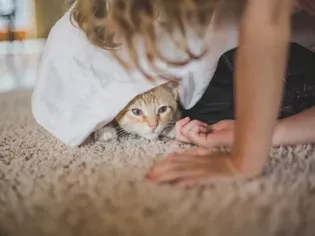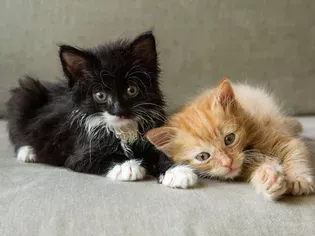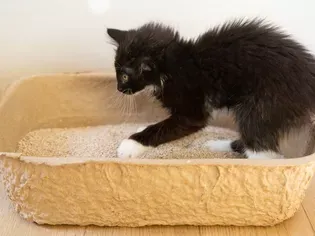Is Your Cat Scared of People?
Updated on 05/26/24

Is Your Cat Scared of People? Here's What You Can Do
Is your feline companion exhibiting signs of fear or anxiety around people, making it difficult for you to share your home with visitors or even bond with your own pet? Understanding the reasons behind your cat's fear and implementing effective strategies can transform your relationship and create a more harmonious living environment.
Understanding the Roots of Fear
Cats are naturally cautious animals, and certain experiences or environmental factors can trigger fear responses:
* Negative encounters: Unpleasant experiences with people, such as rough handling, loud noises, or being forced into unfamiliar situations, can leave lasting imprints on a cat's memory.
* Socialization issues: Kittens who are not adequately socialized with humans during their early developmental period may grow up to be fearful of people.
* Medical conditions: Underlying health issues, such as pain or discomfort, can manifest as fearfulness.
* Environmental stressors: Changes in the home environment, such as moving to a new location or introducing a new pet, can trigger anxiety in cats.
Signs of Fear in Cats
Recognizing the signs of fear in cats is crucial for understanding their emotional state:
* Body language: A fearful cat may adopt a hunched posture, with its ears flattened against its head, its tail tucked in, and its pupils dilated. It may also avoid eye contact and attempt to flee from perceived threats.
* Vocalizations: Hissing, growling, or meowing in a high-pitched, anxious tone are common vocal cues of fear in cats.
* Behavior: Fearful cats may display avoidance behaviors, such as hiding or withdrawing from social interactions. They may also exhibit self-grooming excessively or engage in destructive behaviors like scratching or biting.
Strategies for Reducing Fear
Creating a safe and comfortable environment for your cat is essential for reducing fear. Consider the following strategies:
1. Gradual Socialization:
* Start by exposing your cat to people from a distance, gradually decreasing the distance over time.
* Ensure interactions are positive and non-threatening. Offer treats or favorite toys during these encounters.
* Avoid overwhelming your cat with excessive attention or affection initially. Respect its boundaries and allow it to approach you on its own terms.
2. Create Safe Spaces:
* Provide your cat with designated safe spaces, such as a cat tree or a secluded room, where it can retreat when feeling anxious.
* Consider using pheromone diffusers or sprays to create a calming atmosphere in the home.
3. Positive Reinforcement:
* Reward your cat with treats, praise, or playtime whenever it interacts with people in a calm and relaxed manner.
* Avoid punishing or scolding your cat for fearful behavior, as this will only reinforce its anxiety.
4. Seek Professional Help:
* If your cat's fear is severe or persistent, consider consulting with a veterinary behaviorist or certified animal behaviorist. They can provide professional guidance, evaluate underlying medical conditions, and develop tailored behavior modification plans.
Examples of Effective Strategies
* Case 1: A cat named Mittens was terrified of strangers after being mistreated in her previous home. Her owner gradually introduced her to visitors by having them sit quietly in the same room, offering her treats at a distance. Over several weeks, Mittens became comfortable with the presence of strangers and now enjoys gentle petting from new people.
* Case 2: A kitten named Whiskers was not properly socialized with humans and was initially fearful of any interaction. His owner started by playing with him using a wand toy from a distance, gradually reducing the distance as Whiskers became more comfortable. With patience and positive reinforcement, Whiskers transformed into a playful and affectionate cat who loves attention from people.
Remember:
Overcoming fear in cats requires patience, consistency, and a compassionate approach. By understanding the reasons behind your cat's fear, creating a safe and supportive environment, and implementing effective strategies, you can help your feline companion conquer its fears and enjoy a happy and fulfilling life by your side.
Explore More Pets

Cat Behavior Problems
How to Stop Aggression in Kittens

Long-Haired Cat Breeds
Siberian Cat: Breed Profile, Characteristics, & Care

Cat Behavior Problems
How to Stop Kittens From Scratching and Biting

Long-Haired Cat Breeds
Turkish Angora: Cat Breed Profile, Characteristics & Care

Basic Training
How to Socialize Your Kitten

Short-Haired Cat Breeds
Cute Pictures & Facts About Calico Cats & Kittens

Litter Box Training
Training Your Kitten to Use the Litter Box

Long-Haired Cat Breeds
10 Fun Facts About White Cats
